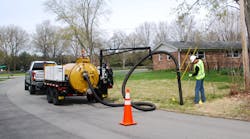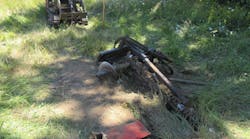It's one thing to install water mains in newly developed areas and quite another to do the work in one of the oldest sections of a major Northwest city, where existing utilities lurk below the surface, as-builts are a fantasy and maintaining traffic flow is a constant concern.
Portland-based Moore Excavation Inc. has been proving this point for nearly a year as its crews replace aging water mains for the Portland Bureau of Water Works in the city's downtown area. The Downtown Mains Improvement Project is upgrading and redistributing the downtown water supply to accommodate the removal of existing water mains for construction of light rail on the Portland Mall.
The $8-million project will install new 36-inch-diameter water mains on sections of SW Clay Street, SW 3rd Avenue, SW Columbia Street, and SW Broadway. According to the bureau, the work will improve reliability and increase the capacity of the water system by upgrading key sections of the 50- to 60-year-old downtown pipe network. The improvements will address several system vulnerabilities, such as aging pipes and multiple mains in the same right of way. Murray, Smith & Associates Inc., Portland, was the design consultant on the project.
"It's a bigger job than we normally do," said Allen Kalkhoven, Moore Excavation's vice president of construction. "It's a pretty good-sized job for the bureau, too. They don't have that much 36-inch water main."
Welded Steel PipeThe project was originally envisioned using ductile iron pipe for the 6,250 linear feet of water mains but was offered for bid with steel pipe as an option, Kalkhoven said. After carefully studying the specifications, Moore chose to bid the project with steel pipe, the only contractor to do so, and got the job.
Kalkhoven, who also is serving as project superintendent, said the tight spaces along the narrow city streets where the work was to take place would have made it nearly impossible to bolt up the fittings of ductile iron pipe and still have room to shore the trenches safely.
"With steel, we can weld the pipes from the inside, and a narrower trench is possible, too," he explained. The contractor is self-performing about 75 percent of the welding and subcontracted the rest to DDJ Construction Welding of Seattle.
For the most part, the trenches are 66 inches wide with an average cut of 10 feet to 11 feet, though one section on Broadway may go down 22 feet unless it's redesigned, Kalkhoven added. There also are six places in the project where trenching isn't feasible — four crossings of the streetcar tracks and two major intersections. Moore will self-perform 48-inch-diameter bores under the intersections, and Gonzales Boring & Tunneling Inc. of North Plains, Ore., will do the streetcar bores.
An interesting aspect of the project is that it replaces the oldest water main in the city of Portland. The 12-inch-diameter pipe was installed in the late 1800s, before the water bureau was formed, and the contractor went to great lengths to avoid damaging it.
"It was scary to dig around that thing," Kalkhoven recalled.
To handle the digging, Moore Excavation has used a Komatsu PC 228 USLC zero-tailswing excavator as its mainline machine and a Case CX135 CSO zero-tailswing model for backfilling. Kalkhoven said his crews have really appreciated the combination of power and compact size that these machines have brought to the tight confines of the project. Other machines on the project include Case CX130 and CX210 excavators and John Deere 444H loaders.
Maze of UtilitiesIt came as no surprise that the contractor for the Water Bureau had to construct the underground pipelines amidst a web of other utility lines, including gas, electric, phone, abandoned steam lines, and fiber optic ducts.
"It's a utility nightmare," Kalkhoven observed. "You expect it, but you don't know how bad they are until you get here. We have done as much redesign as possible to get around them."
The old steam lines required asbestos abatement, and Moore called on Lake Oswego Insulation to subcontract that work.
The contractor also has applied one of its own specialties to the project during the utility work. One of only two companies in the Portland area specializing in pipe-bursting, Moore utilized its Vermeer Hammerhead mole to replace four blocks of 16-inch-diameter sewer line and three blocks of 12-inch-diameter sewer line with HDPE pipe.
"That's all finished — no problems there," Kalkhoven reported when PB&E visited the project in mid-February. He estimated the pipe-bursting work took about one-and-a-half to two weeks per block to complete.
The other major challenge on the project is managing the traffic flow through the work areas. Moore's project engineer, Andy Coate, spends a lot of his time coordinating with officials of the city and the bureaus on traffic and utilities.
"Flexibility is a key," Coate said, adding that Rick Lapp, project manager for the city, has gone out of his way to get timely resolutions to the few issues that have come up.
The efforts have paid off. At this writing, the project has recorded zero traffic incidents, Kalkhoven said.
Additionally, the Water Bureau staff has worked with the representatives of affected businesses and buildings to reduce potential inconveniences to customers and tenants as much as possible. The bureau provides advanced notice if water service must be temporarily interrupted.
The disruptions will all be over soon for businesses and residents in the project area. Work is scheduled for completion in July 2007.




